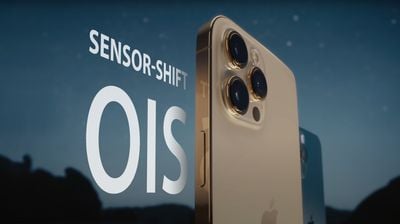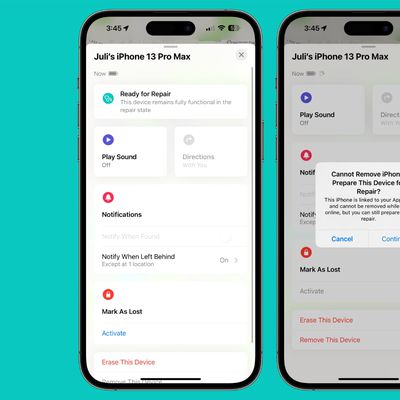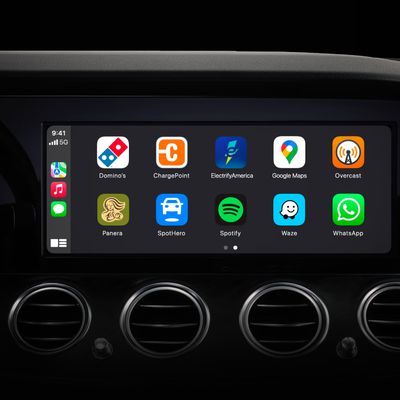Sensor-Shift Camera Stabilization Expected on All iPhone 13 Models
While sensor-shift optical image stabilization is currently limited to the iPhone 12 Pro Max, the feature will be expanded to all iPhone 13 models later this year, according to Taiwanese supply chain publication DigiTimes.

From the report, with emphasis added:
The VCM makers mainly deliver shipments for Android handsets in the first half of the year, but such shipments are expected to be surpassed by those for iPhones in the second half, given that all new iPhones will feature the sensor-shift OIS (optical image stabilization) function, the sources said, adding that the makers have been told to raise capacity by 30-40% to meet strong demand for iPhones.
DigiTimes already floated this rumor in January, but today's report provides further assurance as iPhone 13 models move towards mass production.
Apple first introduced sensor-shift stabilization on the Wide lens of the iPhone 12 Pro Max. The technology stabilizes the camera's sensor instead of the lens for even greater image stabilization and improved photo quality.
"Until now, sensor‑shift stabilization was only on DSLR cameras," explains Apple's website. "This is the first time it's been adapted for iPhone. Whether you're shooting video of your kids as you chase them around the park or holding your iPhone out the window on a bumpy road, you'll get more precise stabilization than ever."
iPhone 13 models are expected to have slightly larger rear camera bumps, likely to accommodate larger sensors and other camera improvements.
Popular Stories
Apple is expected to announce iOS 18 during its WWDC keynote on June 10, and new features have already been rumored for many apps, including Apple Music, Apple Maps, Calculator, Messages, Notes, Safari, and others. Below, we recap iOS 18 rumors on a per-app basis, based on reports from MacRumors, Bloomberg's Mark Gurman, and others: Apple Maps: At least two new Apple Maps features are...
With the 10th anniversary of the Apple Watch approaching, we thought it would be fun to take a look back at an interesting bit of Apple Watch history. After the Apple Watch was announced in 2014, and before it became available in 2015, Apple sent out custom Apple Watch iPad demo kiosks to retail stores. The Apple Watch and iPad units used for these devices were specially designed, had custom ...
While Apple's upcoming iPad Pro models have been expected to feature the M3 chip for over a year, recent reports have unexpectedly suggested that the new devices will instead feature the as-yet-unannounced M4 chip. Subscribe to the MacRumors YouTube channel for more videos. Last week, Bloomberg's Mark Gurman said that he now believes there is a "strong possibility" that the upcoming iPad Pro ...
With iOS 17.5, Apple is adding a "Repair State" feature that is designed to allow an iPhone to be sent in for service without deactivating Find My and Activation Lock. The fourth iOS 17.5 beta that came out today adds a "Remove This Device" option for all devices in Find My, and using it with an iPhone puts that iPhone into the new Repair State. Right now, sending an iPhone to Apple to be...
An in-depth Bloomberg report today resurfaced General Motors' decision to replace Apple CarPlay with its own software. Last year, GM announced that it planned to forgo Apple CarPlay in its new electric vehicles, starting with the 2024 Chevrolet Blazer EV. Instead, the automaker introduced a proprietary infotainment platform, aiming to control and customize the digital experience within its...
Amazon today kicked off numerous discounts across multiple Apple products and accessories, the highlight being the AirPods Pro 2 with USB-C for $179.99, down from $249.00. You'll also find deals on the Apple Pencil 2, AirTags, and Studio Display. Note: MacRumors is an affiliate partner with Amazon. When you click a link and make a purchase, we may receive a small payment, which helps us keep...
Apple has announced it will be holding a special event on Tuesday, May 7 at 7 a.m. Pacific Time (10 a.m. Eastern Time), with a live stream to be available on Apple.com and on YouTube as usual. The event invitation has a tagline of "Let Loose" and shows an artistic render of an Apple Pencil, suggesting that iPads will be a focus of the event. Subscribe to the MacRumors YouTube channel for more ...























Top Rated Comments
On standalone cameras, optical image stabilisation (OIS) normally means moving a single (small) lens element somewhere in the centre of the lens in at least two directions (up/down and left/right), possibly also tilting it in two dimensions, compensating for camera movement. Camera movement can be split up into linear movement (up/down, left/right, forward/backwards) and rotational movement, tilting up/down, left/right, but also around the optical axis. OIS cannot compensate for that last kind of movement direction.
Lenses in smartphones are so small and so tightly packed that moving individual lens elements isn’t really possible. OIS is thus implemented via the complete lens assembly moving. Whether only linear movements ('https://www.quora.com/What-is-the-optical-image-stabilization-feature-on-a-smartphone') or tilting or even both might vary, this article ('https://www.newelectronics.co.uk/electronics-technology/how-technology-is-bringing-sharper-images-to-users-of-smartphone-cameras-and-videos/61637/') describes (small) tilting movements. With tilting, the whole lens+sensor package might tilt as described here ('https://www.quora.com/unanswered/Which-smart-phones-camera-support-full-optical-image-stabilization-OIS-for-its-zoom-Periscope-Lens-mode').
In standalone cameras with interchangeable lenses the clear trend has been to move from OIS to sensor-based image stabilisation (usually referred to as in-body-image-stabilisation, IBIS, as being in the camera body not the individual lenses), except for longer tele lenses. This has a number of advantages, not all applying to phones. For once, this requires only one stabilisation unit inside the camera instead of having one in every individual lens. Not only does this save money and weight, OIS based on moving individual lens elements also requires a more complex lens design such that there is small enough lens element whose movement can achieve this task (small because moving a large element would add size and most importantly would require very powerful actuators to move quickly enough, additionally, whatever you move should be only a small fraction of the weight of the total camera+lens unit), and moving the lens element should not affect the optical performance too much (which also works better with a centrally-located lens element).
Except for longer tele lenses, IBIS has proven to provide a better stabilisation performance and also enables the compensation of rotation around the optical axis. Given the more simplistic OIS in smartphones, I am not surprised that sensor-based IS can achieve better results here as well (on top of adding optical axis rotation correction). Moving only the sensor is also certainly easier than moving sensor plus lens and probably requires less space to move things back and forth (as you are moving something smaller, maybe also lighter).
One last point, the requirements for stabilisation with still image photography and video are somewhat different. For the former you just need to correct for camera movement for the time the ‘shutter is open’ during the exposure (but that exposure time might be relatively long). With video, you also want to achieve small and smooth movements of the camera from video frame to video frame (while the exposure time will always be as short or shorter than the frame rate). With OIS in standalone cameras, you’d want the corrective lens element to move such that it compensates the camera movement but at same time do so while as close as possible to its neutral position (as the optical design is based on all lens elements being lined up perfectly). When shooting video the additional corrective action for camera movement from frame to frame makes that pretty difficult. Here, sensor-based stabilisation avoids that issue but also appears to perform better in general in achieving smooth video.